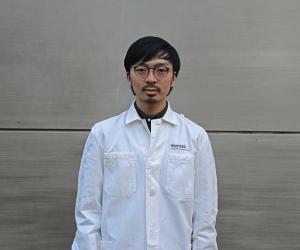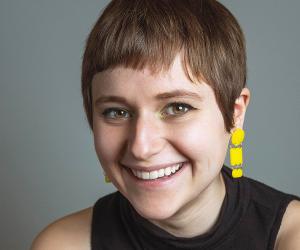
Think about the average day and the activities within it. Chances are you’re using materials that are harmful to the earth, consuming products made from resources that are under strain, or purchasing more products that repeat the cycle.
While the reality is grim, these issues have inspired designers to step up to the challenge of innovating so that the future is actually something we’ll get to experience.
Clothing industry
The UN has described fashion as an environmental and fashion emergency. The industry is responsible for ten per cent of global carbon emissions, a proportion so big it exceeds the combined emissions of international flights and maritime shipping. Add to that the increased pace of production alongside the decline in use-per-garment, fashion is not a good look for the environment right now.
In response to this, Kye Shimizu is harnessing machine learning to produce zero-waste couture. Using 3D CAD software and algorithms, the technology enables mass customisation of garments without creating surplus.
They’re customised using digitally captured body data, then assembled via a digital fabrication process that produces no waste.
Plastic waste
With only ten per cent of the world’s single-use plastic being recycled and the rest filling landfills and oceans, it’s become one of the most pressing environmental issues.
Bottled beverages contribute massively to environmental waste. The production of a 500ml bottle requires 3 - 4 litres of water. This highlights the waste generated at both the beginning and end of use.
Rodrigro Garcia Gonzalez has devised packaging that is both biodegradable and edible.
Made of seaweed, the Ooho! Capsule is a membrane-like alternative to the conventional water bottle. Gonzalez chose seaweed because of its abundance and the ease of access. Growing six metres per week and with no need for farm land, water or fertilisation, it presented itself as the perfect material for this purpose.
While Gonzalez is aiming to eliminate plastic, Dave Hakkens is finding new uses for that proportion that does get recycled. His Precious Projects initiative makes it possible for recycling to take place at a small scale through the use of specifically designed machines that enable injection, extrusion, shredding, compressing and moulding.
An open-source blueprint is available so the idea can be replicated anywhere in the world. In addition, the project includes an online marketplace, where the products created with these machines are sold.
E-waste
Just like the fashion industry is churning out garments faster than consumers can keep up with, so too is the electronics industry constantly releasing new models. As consumers upgrade, a mass of e-waste is accumulated, which is often shipped to dumps across Africa and Asia.
Hakkens’ first foray into waste reduction started with the e-waste problem. In response he designed PhoneBloks, a modular mobile phone that made it possible to replace faulty parts of the device, rather than the entire device.
In a radically unconventional approach to how we consume technology, cyborg artist Neil Harbisson has merged his body with it. Born colourblind, he had an antenna implanted into his skull, so is able to identify colours via audio vibrations. He says his brain is part software, and his software part brain.
He also experimented with a bluetooth-enabled tooth with friend and fellow cyborg Moon Ribas, which enabled the pair to communicate in code via tooth clicks.
While tech-infused humans is an entirely new concept to grasp, their experiments open up the discussion on the value of artificial human senses vs. the constant need to impact the planet for the sake of humans.
“I think the more we design ourselves the less we’ll have to design the planet and the less we’ll have to change it,” says Harbisson.
Food of the future
Alongside redesigning ourselves as a species, comes the question of re-assessing what we put into our bodies too - less for our health and more for the health of the planet. The natural resources required to farm livestock like land and water are growing increasingly scarce globally. Wild and forest land have been cleared to accommodate for agriculture in many parts of the world.
Couple this with the greenhouse gas emissions as a result of livestock farming, and all of a sudden that steak doesn’t sound so appealing anymore. The Guardian reports that beef results in up to 105kg of greenhouse gases per 100g of meat.
Aware of food’s ever-evolving nature, designer and researcher Carolien Niebling is exploring ways to reducing meat consumption without making the industry completely obsolete. She is working with traditional meat butchers to create the ‘Sausage of the Future,’ comprised mainly of plant-based and insect elements.
Using design as the medium to bridge science and food, Niebling suggests that the move away from meat be a gradual one and as a result her initial sausages are completely meat-based, but their proportion of meat has been significantly reduced.
Water wastage
The conversation about sustainability is really a conversation about deluge too. There is just too much of everything. One example is the overwhelming amount of choice in something as mundane as the detergents isle at your local supermarket. With loud branding screaming for attention, the competition is fierce.
Beyond the rampant impact of its plastic packaging, this got product designer Mirjam de Bruijn thinking around the environmental effects of the whole system, beginning with the detergents’ ingredients. With most of these products made up of 80% water, de Bruijn questioned why that proportion couldn’t be added in the home, rather than transporting all that water from distribution to supermarket to consumer.
The result is a range of products called Twenty, which reduces the product down to its simplest state in capsule form without the water element. The concept could signal a massive change in the industry and the way things are done in a resource-starved future.
Death
Not even death can stop us from harming the Earth as individuals. When one considers the harmful materials used to make coffins and the lifetime of toxins contained in the human body, it gives a depressing sense of what goes back into the earth at death.
With an innovation so telling of our times - that we need to think around sustainability in our death - Shaina Garfield designed Leaves, a coffin and burial method that helps the body to decompose naturally. The ritual involves wrapping the body in cloth, with the traditional coffin replaced by a fungus-infused rope, which is what aids the decomposition, but also feeds the surrounding soil.
“Once a body is buried, fungus grows to speed up decomposition. It also eats our toxin, so only our nutrients like oxygen and nitrogen going into the soil. At death we can use fungus to humble our species for the good of the earth,” says Garfield.
It’s a beautiful exploration of how individuals can contribute to life on Earth beyond living, and is particularly pertinent given how much damage one will have - albeit inadvertently - caused over a lifetime of merely existing.












